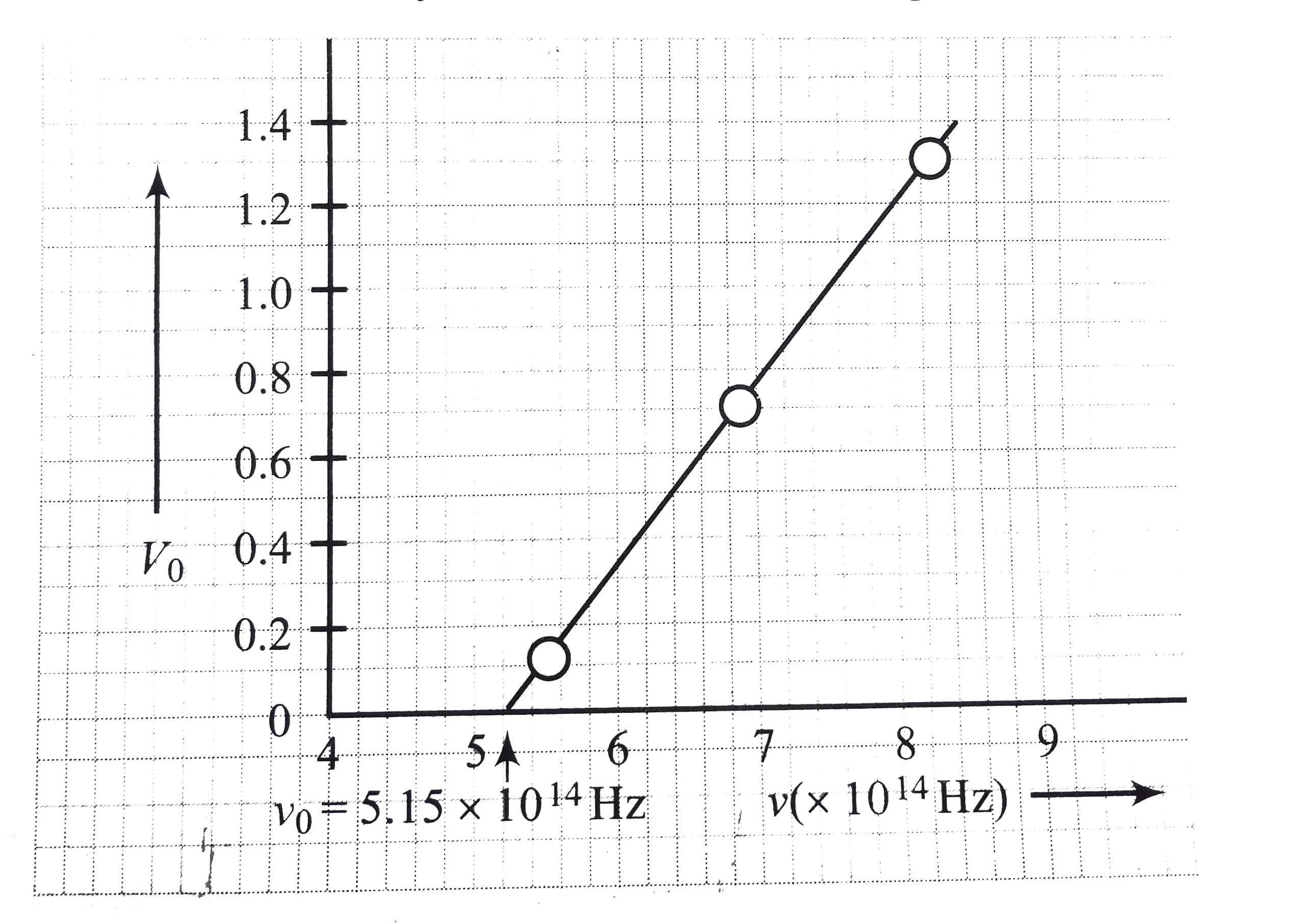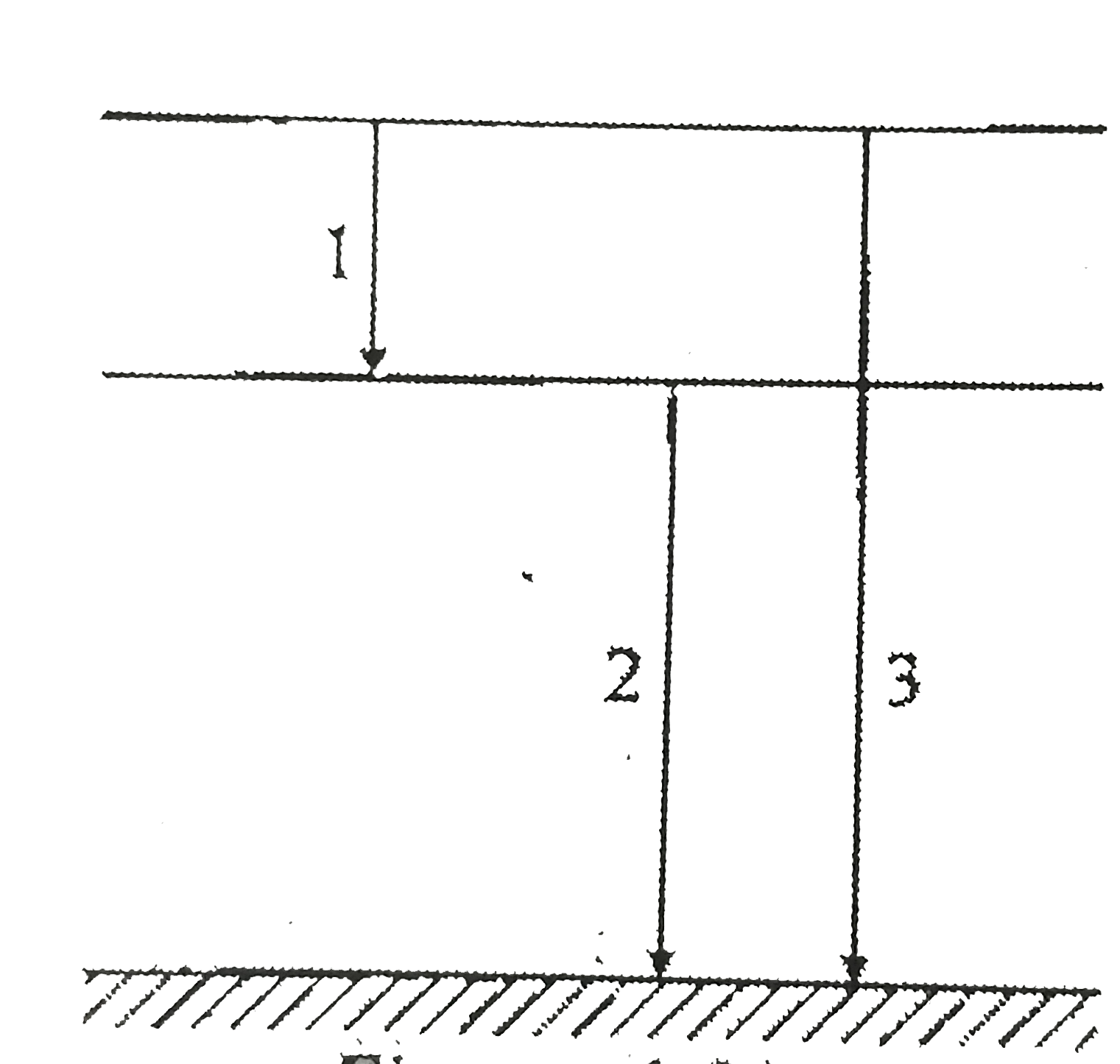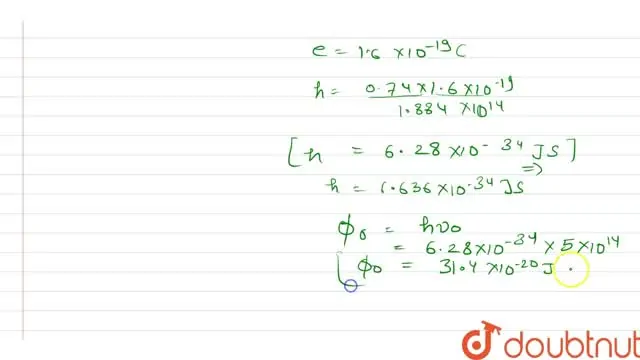A mercury lamp is a convenient source for studying frequency dependence of photoelectric emission, since it gives a number of spectral lines ranging from the UV to the end of the red visible spectrum. In our experiment with rubidium photocell, the following lines from a mercury source were used: λ1=3650A∘,λ2=4047A∘,λ3=4358A∘,λ4=5461A∘,λ5=6907A∘ The stopping voltages, respectively were measured to be:
V01=1.28V,V02=0.95V,V03=0.74V,V04=0.16V,V05=0V.
(a) Determine the value of Planck's constant h.
(b) Estimate the threshold frequency and work function for the material.

a. Let the respective frequencies fo the five spectral lines of mercury be V1,V2,V3,V4 and V5. Then
V1=cλ1=3×1083650×10−1=8.22×1014Hz
V2=cλ2=3×1084047×10−10=7.41×1014Hz
V3=cλ3=3×1084358×10−10=6.88×10−10Hz
V4=cλ4=3×1085461×10−10=5.49×1014Hz
and V5=cλ5=3×1085461×10−10=4.34×1014Hz
From Einstein's photoelectric equation, we have
hv=hv0+12mv2max
If V0 is the stopping potential, then
eV0=12mv2max
hv=hv0+eV0
or V0=hce−hv0e
It represents the equation of a straight line, whose slope is he and makes an intercept hv0e on negative. V0−aξs. The plot of graph between v (along X-axis) and V0(along Y-axis) for the given data for the five spectral lines of mercury will be as shoen in fig

From the graph, slope of the graph is
1.28−0.168.22×1014−5.49×1014l=4.1×10−15JsC−1
he=4.1×10−15
or h=e×4.1×10−15
=1.6×10−19×4.1×10−15
=6.57×10−34Js
b. Also the intercept made by the graph on v-axis is equal to v0. Therefore, from the graph, we have
v0=5.15×1014Hz
Hence, the work function of rubidum,
w=hv0
=6.456×1034×5.15×1014
=3.38×10−19J=3.38×10−191.6×10−19=2.11eV
Related Playlists
- BOOK - CENGAGE PHYSICS ENGLISHCHAPTER - PHOTOELECTRIC EFFECTEXERCISE - Examples8videos
PHOTOELECTRIC EFFECT
- BOOK - CENGAGE PHYSICS ENGLISHCHAPTER - PHOTOELECTRIC EFFECTEXERCISE - Exercise 3.115videos
PHOTOELECTRIC EFFECT
- BOOK - CENGAGE PHYSICS ENGLISHCHAPTER - NUCLEAR PHYSICSEXERCISE - ddp.5.514videos
NUCLEAR PHYSICS
- BOOK - CENGAGE PHYSICS ENGLISHCHAPTER - RAY OPTICSEXERCISE - DPP 1.612videos
RAY OPTICS
Similar Questions
A photon of frequency v causes photo electric emission from a surface with threshold frequency v0. The de-Broglies wavelength (λ) of the photo electron emitted is given by:
View SolutionIn photoelectric effect the slope of straight line graph between stopping potential (Vs) and frequency of incident light (v) gives
 View Solution
View SolutionIf the threshold frequency of a metal for photoelectric effect is v0 then which of the following will not happen ?
View SolutionA sine wave has an amplitude A and wavelength λ. Let V be the wave velocity and v be the maximum velocity of a particle in the medium. Then
View SolutionWhen a metallic surface is illuminated with radiation of wavelength λ, the stopping potential is V. If the same surface is illuminated with radiation of wavelength 2λ , the stopping potential is V4. The threshold wavelength surface is :
(a) 5λ (b) 52λ (c) 3λ (d) 4λView SolutionThe resistance of metal is given by V=IR, The voltage in the resistance is V=(8±0.5)V and current in the resistance is I=(2±0.2)A, the value fo resistance with its percentage error is
View Solutionwhen a monochromatic point source of light is at a distance 0.2 m from a photoelectric cell, the saturation current and cut-off voltage are 12.0 mA and 0.5 V. If the same source is placed 0.4 m away from the photoelectric cell, then the saturation current and the stopping potential respectively are
View SolutionFor a photoelectric cell the graph showing the variation of cut of voltage (V0) with frequency (v) of incident light is best represented by
 View Solution
View SolutionThe wavelengths and frequencies of photons in transition 1,2 and 3 for hydrogen like atom are λ1,λ2,λ3,v1,v2 and v3 respectively. Then:
 View Solution
View SolutionWhen radiation of wavelength λ is used to illuminate a metallic surface , the stopping potential is V. When the same suface is illuminated with radiation of wavelength 3λ the stopping is V4 . If the therehold wavelength for the metallic
View Solution


